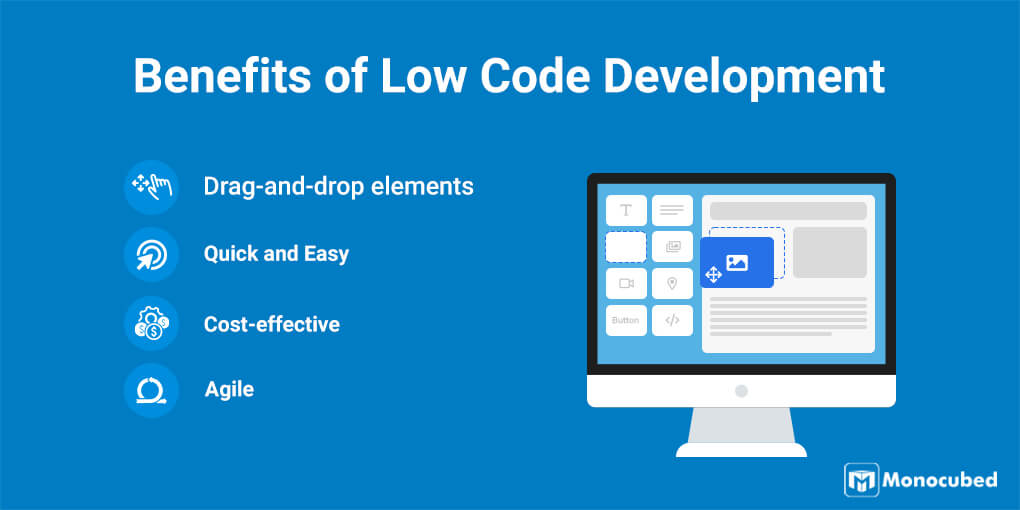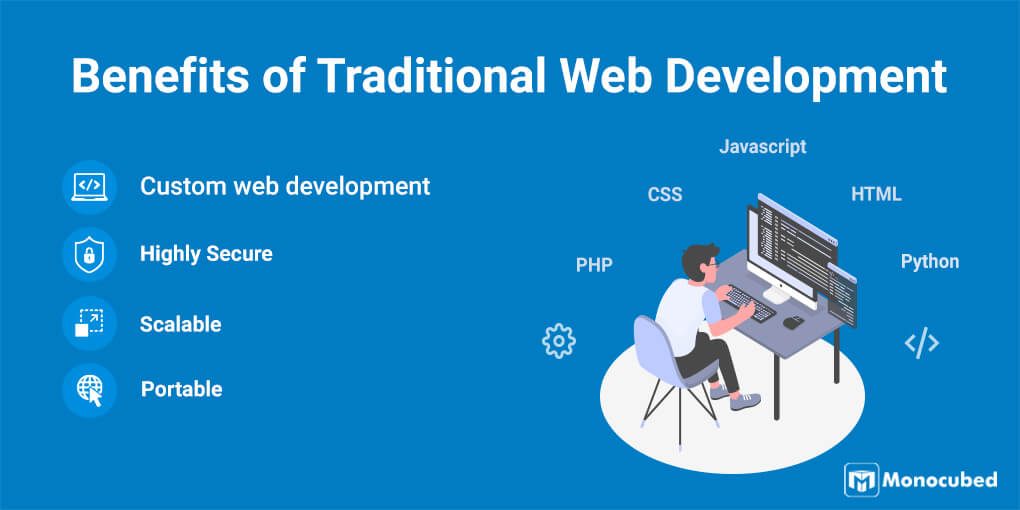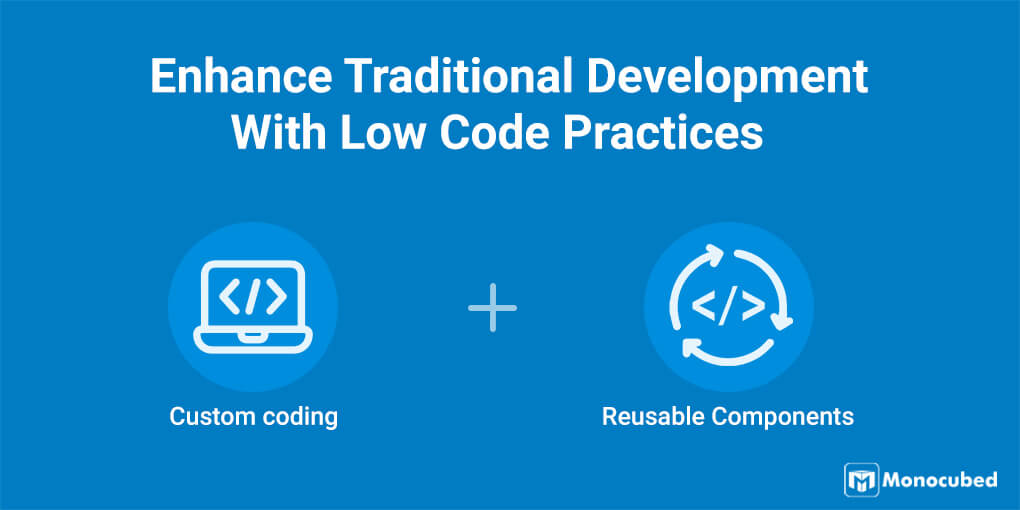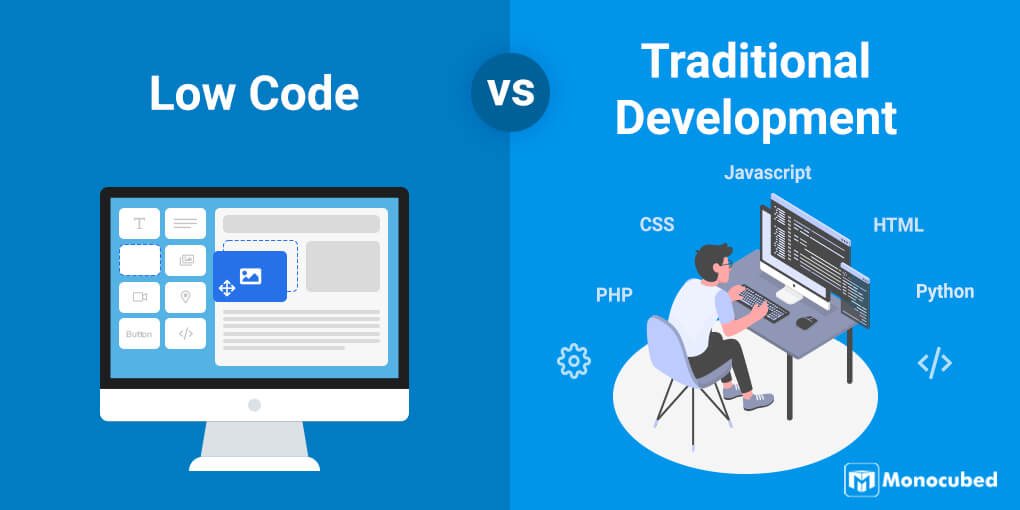According to a study conducted by Appian and Forrester Consulting, 84% of enterprises are using low-code development for –
- Reducing strain on their IT resources
- Increasing speed-to-market
- Involving the business in digital asset development
But does your project require low-code development? Or is your business more suited to traditional development?
We are here to solve your doubts.
In this blog, we explore the low code vs traditional development approaches. Read on to find out if you should hop on the trend of low code or no-code web development or stick to the traditional web development.
Table of Content
- Low Code vs Traditional Software Development – Quick Comparison
- Understanding Low Code and Traditional Development
- What is Low Code App Development?
- What is Traditional App Development?
- So Which Web Development Method Should You Be Using?
- Use Low Code Practices With Traditional Development
- FAQs
- Key Takeaways
Low Code vs Traditional Software Development – Quick Comparison
Before we get into the details of what is low-code development and its pros and cons, here is a quick comparison table of low code vs traditional development. Read to get a quick and easy overview of the blog.
Property |
Low Code Development |
Traditional Development |
|---|---|---|
| Definition | Low code development is developing software applications using a graphical user interface i.e. visual modeling. | Traditional development is developing software applications using manual coding. |
| Tools | Rapid application development tools such as Mendix and Appian are used for low-code web app development. | Web frameworks and programming languages are used by developers to hard-code web applications. |
| Coding Knowledge | Minimum knowledge required. Low code developers require basic coding knowledge. | Professional web developers with advanced coding skills and knowledge of multiple web frameworks work with traditional web apps. |
| Speed of Development | Low code development platforms (LCDP) are known for their rapid development. You can develop a working web app in just 1-3 weeks. | Traditional development requires hardcore coding and may take 2-8 months to complete. But when it comes to performance, traditional works better. |
| Customization | With LCDP platforms you can add very limited customization to your web app. | With traditional coding, the web app can be tailored to meet your specific requirements. |
| Agility | Low code apps are more agile because you can make changes quickly. Your new app releases will be quicker and any errors can be backtracked and resolved immediately. | With traditional custom development, changes can be slow. But by following agile development practices, traditional web apps can be agile. |
| Deployment | Deploying low code apps is fast. But you have access to limited platforms. Depending on the low code tools you are using, you can deploy only to supported platforms. | With traditional web apps, you are free to deploy to any and all platforms. |
| Quality |
|
|
| Maintenance | Low code apps are easy maintenance comparatively. When the company updates the low code platform, your low code web apps will be automatically updated. So you spend minimal resources in the regular maintenance. | Custom-built web apps can be tough to regularly update and maintain. You need a dedicated team to update the code each time. |
Understanding Low Code and Traditional Development
Let’s take a simple example of Canva and Photoshop to understand the key differences between traditional development and low-code development.
Imagine you want to develop an attractive banner for your business’s website. You have two approaches for the same.
Approach 1 – Photoshop
You can plan and design properly according to your requirements with this approach. The process you follow with Photoshop is –
- You brainstorm ideas/concepts you want to portray with the design.
- You plan the content to highlight, the theme to use, the different shapes to use along the colours to properly convey your idea.
- Design each element from scratch, adding layers to get the desired graphics.
- Add content if any.
- Your custom banner is ready.
Approach 2 – Canva
The other approach to designing the banner is using a tool like Canva.
- You select the ideal dimensions and start designing.
- Browse ready-made design formats and templates and select the one that matches your idea.
- Drag and drop the elements you require.
- Copy the content if any.
- Add customization – Resize, apply colours of your choice.
- Your banner is ready.
With robust graphic design tools like Photoshop or AdobeXD, you have to customize each element. It takes time and manpower to get the design ready. But you get a design that is exactly as imagined and planned.
With automated or ready-to-use design tools like Canva, you can design an image within a few hours. It is fast and easy. But you are limited by the templates or elements available. You can add limited personalization.
Now coming back to our topic at hand – traditional vs low code development. Traditional development is a lot like using Photoshop. You plan, you design, you build everything from the ground up.
Low-code development, as you can guess, is more like Canva. You drag and drop pre-configured modules to the graphic interface, add less customization code and your software is ready to use.
Have a Web App Idea for Your Business?
Get your idea validated by professionals. Discuss unique features to add. Know the cost of development. Know the timeframe. Let’s start building.
Now that you know the concept behind traditional development and low code development, let’s look at the pros and cons of both development approaches.
What is Low Code Development?
Low code development is the software development approach that uses ready-made templates and pre-coded modules. Low code development platforms are for both beginners and professional web developers. They can quickly develop standard applications with very little manual coding. Best no code tools can further simplify the process by eliminating the need for any coding whatsoever.
Low code platforms have a drag-and-drop interface. You just have to draw the flow diagram and the application will be built. With a few code lines to add personalization, the web app is ready to be used.

People with limited coding knowledge can also create web software by just dragging the modules and placing them in order. You can develop a fully-functional web solution with minimal coding using a low code development platform.
Even low code web design is easier. You don’t need to learn advanced tools like Photoshop or Adobe XD to make striking web page designs.
What is the Difference – Low Code vs No Code Development?
Low code development is generally confused with no-code development. No-code development platforms are for people with no technical knowledge. They can develop apps by using drag-and-drop elements. Low code, on the other hand, requires some technical knowledge. It is for developers who want to develop applications quickly by dragging-dropping elements and customizing them with their code.
Advantages and Disadvantages of Low-code Development
Let’s analyze the pros and cons of low code development for web projects.
Advantages of Low-code Development |
Disadvantages of Low-code Development |
|---|---|
| Speed of Development is High –
You have to invest very little time in development. You can have a working application ready within just 1-3 weeks. This means quicker time-to-market and improved agility for developers. |
Quality Can Be Low –
When you use pre-written modules, sometimes it can affect the quality of your app. |
| Low Cost for App Development –
Even if you factor in the cost of buying an app builder and ready-to-use templates, the cost is very low compared to the cost of developing a web app with the traditional method. |
Low Customization –
Customization is something you have to sacrifice if you use a low code platform. Even if some platforms provide customization to an extent, you need technical proficiency to add personalization. |
| Minimal Technical Knowledge Required –
Most low code platforms have a drag and drop workflow. Any person with just beginner-level coding skills can create a fully-functional web app. |
No Portability –
Deployment options are very limited when using a low-code platform. In addition, if you want to change the platform for some reason, code migration is almost impossible. |
| Low Risk With High ROI –
With minimal investment of $5- $1000/month and only 1 developer, you can develop a web app. Data management, security features, and testing modules are all included in the low code platform. |
No Scalability –
Low code applications are not suitable for a large audience. If you want to scale it to enterprise solutions, low code platforms are not an appropriate choice. |
Now let’s look at what the traditional development methods are and how it stands against low code.
What is Traditional App Development?
Traditional application development is a custom software development approach where software engineers code software from scratch.
Traditional development requires technical proficiency, unlike low code. You need to hire professional web developers to manually code and design the software solution.
When you want to develop a completely customized web application or website, you need the traditional development approach. The software developers will write custom code for each feature. There is no place for off-the-shelf software solutions.

A web developer follows all the stages of a web development lifecycle from requirement gathering and research to testing and deployment.
In addition, traditional development projects need a sizable investment of time, money, and resources.
But the product quality is high and everything is built as per your request. The developers can implement advanced features if required with minimal effort as they are experienced and have a wide development knowledge base.
Increase Your Productivity With Custom Web Solutions
With custom-built web solutions, you can increase productivity and efficiency of your business processes. Just like our custom subcontractor management software that spiked productivity by 37% for our client.
Advantages and Disadvantages of Traditional Development
Let’s analyze the pros and cons of traditional development for web projects.
Advantages of Traditional Development |
Disadvantages of Traditional Development |
|---|---|
| High Scalability –
With the traditional approach of web development, you have the freedom to scale the app as you require. Since all the code is written from scratch, you can make the code scalable and portable from day one. |
Cost of Development is High–
The cost of developing custom web applications and websites is high. You need to invest more time and resources for a longer period of time to get a highly effective web app. |
| Completely Customizable –
With experienced software engineers in your team, you have the ability to get complete personalization. Whatever feature or functionality you require can be added. |
Time-consuming –
It can take around 2-8 months to develop a custom web application when you are coding each feature from the ground up. Plus due to the complexity of custom application development platforms, there can be delays due to too many errors. |
| Highest Quality Ensured –
In the traditional development approach, you have the freedom to ask for re-coding if something is not up-to-the-mark. With professional developers who work dedicatedly on your project for months on end, quality is ensured. |
Requires a Whole Development Team –
You require a designer, web developers who specialize in web frameworks, and testing engineers to develop a web app in the traditional way. |
| Custom UI/UX Design –
With the traditional web apps, you can design a unique and personalized UI/UX that makes your app stand out. |
So Which Web Development Method Should You Be Using?
Choosing the right development approach is very important. The wrong app development strategy can result in a huge loss of money, time, and resources.
For example, you create a low-code application for managing the attendance of an organization. Now you want to integrate new functionalities like an hour-by-hour tracking of employees or their task management. But the low code platform does not have the necessary templates or elements you need.
Now you are in a pickle because you can’t add the tracking functionality in the existing application. Even if you develop a separate application for tracking and managing tasks, you won’t be able to connect the two apps. The only solution is to hire a web development company that develops the whole application from scratch with both the attendance and task management features.
Therefore it is essential that you carefully analyze the pros and cons of both low code and traditional development method before choosing one.
In this section, we list when to prefer low code web development and when it is better to invest in traditional web development.
When to Go for Low Code Development?
Low code development is the right option for you in these situations –
- When You Require Quick MVP Development
If you are looking to build prototypes or present a working solution to gain investors, it is not advisable to spend thousands of dollars to develop a custom MVP (Minimum Viable Products). With a low code app, you can quickly create a low-cost, low-risk MVP for your idea. Low-code MVP development is faster, cheaper and easier than the traditional development process.
- Static Websites And Web Apps
Low code app development is perfect for simple websites and web apps. When you are developing a static website, there is no need to write HTML and CSS codes. Within just 5-10 hours, you can have a static website or web app up and running.
- When Trying Innovative Ideas
You have an innovative web app idea that may benefit your organization. But you don’t want to waste resources and wait for months to try it out. Use low code web tools for developing apps quickly and easily. You can implement the idea in just 1-3 weeks and if it doesn’t work or requires changes, you can roll it back as rapidly.
When is Traditional Development Better for You?
You should prefer going with traditional development when your project has –
- Require Custom Web Solutions
Of course, as mentioned above, custom app development is almost synonymous with traditional programming. If you require features and functionalities not found in standard solutions, build your web apps with the traditional approach.
- Want Scalability and Performance
If you plan to expand your app in the future, adding in new features and building the app as it goes, then go with custom web development. With traditional web programming, you can optimize each code line to get the highest performance. A custom app can support up to millions of users. So if you require such scalability, invest in traditional web development.
- When You Want to Streamline Your Business Processes
If you are looking to automate your business processes, the traditional web app development is suitable for you. For example, if you want to develop a legal contract management software for your company’s internal use, custom app development is apt.
- Want Integrability and Portability
If you want to integrate your app with other systems or existing databases, a low code app may not work for you. Similarly, if you plan to have a portable code that can be deployed on multiple platforms, traditional application development is right for you.
You might have to code for each platform separately, but it is easier to reuse manually written code for a different platform. Instead of using different low code platforms for different platform apps.
- No Fixed Requirements
When you are not sure what all features you want in the web solution, low code development is not for you. When working with ever-changing requirements, a traditional web development approach is preferred as you have skilled developers who will code as you need and add in whatever feature you require at any point to build custom apps.
Want to Develop a Custom Software Solution?
Get an affordable web-based software solution that is feature-rich, scalable, and integrable with your existing systems. Tailored to your requirements.
Use Low Code Practices With Traditional Development

When examining low code vs traditional, we have realized that low code development does have a lot of benefits. Although low code can not be a replacement for the traditional approach, there are many advantages of low code development.
And smart businesses will incorporate the beneficial practices of low code into the traditional custom app development lifecycle.
Your skilled developers can work smarter with reusable components, standard libraries, and ready-to-use APIs. For example, there is no harm in using the Google Maps API if you want to integrate location functionality into your app.
Enhance your traditional development with the low code practice of reusing. Let your in-house team focus on making the app unique and leave the repetitive coding tasks to a low-code platform.
Frequently Asked Questions
Which is better – low code or traditional development?
Being a leading web development company, we are tempted to say traditional custom web development is better. But the low-code approach has many advantages when used in the right way. There is no single answer. The development methodology you choose depends on what suits your budget, your requirements, your timeline, and the uniqueness of your project.
Should startups use the low-code development approach?
As a startup, if you have limited resources and little time, low code software development is apt for you. You don’t have to invest in multiple developers and give months to develop your app. Low code platforms accelerate your development process. Startups can also use low code MVP development for building prototypes to attract and fulfill the requirements of your stakeholders.
Key Takeaways
So let’s summarize traditional vs low code development in brief.
Traditional or custom development is apt for projects that require –
- Custom solutions
- Scalability
- High performance
- Unique features
- High quality
But go with low code development if you are looking for –
- Rapid development
- Low cost – High ROI
- Easy to learn and use
- Quick time-to-market
- Low tech debt
Still, confused about which is right for you?
No worries. Discuss your project idea with us and get advice from technical experts on what is best suited for you. Contact us to schedule a free consultation with a signed NDA (your idea will remain safe with us).
 By Jeel Patel
By Jeel Patel



